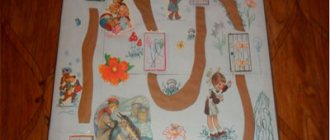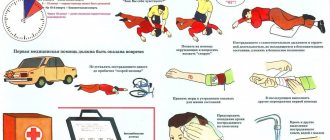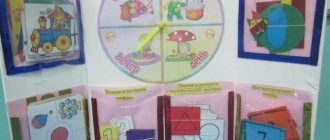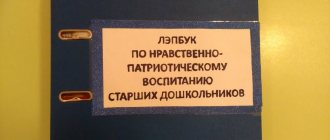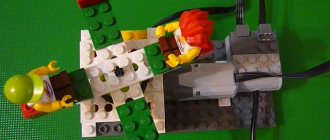Methodical manual “Do-it-yourself sensory toys”
Author:
Taut Irina Petrovna
teacher
MAU DO "Sorokinsky"
child development center - kindergarten No. 1"
The main content of the play of younger preschoolers is actions with toys and substitute objects. Children especially love to play with household objects such as sand, water, various jars, and bottles. Such activities contribute to the development of the child’s sensory system: vision, hearing, smell, taste. If a child receives a rich sensory experience in early childhood, this will help him feel much more comfortable in the future, in adulthood, and will also help him learn successfully. Now many manufacturers have begun to produce wonderful toys for children. These include educational rugs, soft books, sewn puzzles or laces. However, you can make an interesting educational toy with your own hands. Self-made sensory toys carry a charge of positive energy, warmth and tenderness of the hands, and are unique. While working with young children, I noticed that there was a need for the development of fine motor skills, so I had the idea to create a series of toys for sensory development using improvised materials. A variety of items were used: hooks, buttons, laces, Velcro and other improvised materials that can be found in any home. I was looking for various options for educational mats and tablet modules. In general, we got good benefits with a minimum of financial costs. The parents of my students provided a lot of help in making crafts. Together we sewed, glued, nailed, created, invented.
The purpose of these benefits is to develop the sensory abilities of young children, memory, thinking, imagination, develop hand motor skills, and tactile sensations.
The manuals contain tasks and exercises for sensory development, fine motor skills of the hands, speech, logical thinking, imagination, and creative abilities of the child.
All exercises are easy to perform. Their regular repetition contributes to the development of gross, fine and articulatory motor skills, dexterity and coordination of movements. It has a beneficial effect on the development of logical thinking, attention, and memory.
The aids are easy to use; they can be played by one or several children at once in any space, both in a group and on a walk.
Touch cube
Purpose of the manual: To develop children's sensory abilities, speech, attention, imagination, memory, fine motor skills. Form a perception of the quality of objects, teach joint play and interact in a team.
The cube is easy to make, multifunctional, and takes up little space. Several children can play it at the same time. A cube is made from six plastic sink grates, the edges are held together with insulating tape. Inside the cube there are several colored balls of different diameters. A small bell is suspended on the upper edge from the inside.
On each side face on the outside there are various objects for the development of children's sensory abilities. These are ribbons for tying bows, ropes for braiding hair, beads for tactile sensations, Kinder surprise containers with aromatic fillings, small toys, colored clothespins for attaching primary colors.
Mathematical tablet "Geometric"
Purpose of the manual : development of fine motor skills of the fingers, familiarization with geometric shapes. The manual promotes the development of logic, helps to comprehend the basics of geometry, and freely navigate the plane. The manual is made of a wooden board measuring 50x50cm. covered with self-adhesive film. The entire surface is divided into four sectors: yellow, red, blue, green, using power buttons. From 1 to 4 people can play simultaneously. Children are given multi-colored rubber bands with which they depict various geometric shapes: square, triangle, rectangle, oval. The unique technique of “drawing with rubber bands” will give the child the opportunity to feel the shape of geometric shapes with his fingers and teach him to navigate on a plane. Develops attention and perseverance.
Module with locks
Purpose of the manual: An exciting game with locks will help the child develop fine motor skills, learn a lot about the world around him, Promotes the development of arbitrariness, cognitive activity, fine motor skills, ideas about objects and phenomena of the surrounding world, creativity, play activity, memory, combinatorial abilities, abstract thinking. By opening and closing the locks, the child himself can check whether he is doing everything correctly. And if something is wrong, he himself will be able to correct his actions. The implementation of this principle is very important for the development of the child’s independence and his desire to learn. Each door has its own unique lock and color. When opening the door, the child learns to use the closing device (hook, latch, latch) but also sees behind it a picture corresponding to the color of the door. at the bottom of the manual there are various devices for the development of children (socket, switch, calculator). The child learns the purpose of objects, learns to manipulate them, and expands his horizons.
Developmental mat
The purpose of the manual: to develop children's tactile sensations, speech, attention, helps to develop perseverance when working with this rug.
The manual is made from fabrics of different colors and textures. The first row shows different types of fabrics. Children compare fabrics by touch, which is smooth and which is rough and rough.
And in the second row there is faux fur. We compare the length and color of the fur, which animal it belongs to. The third row is presented in the form of a set of geometric shapes. Children learn to name shapes, their colors and their distinctive qualities from each other.
Developmental aid Caterpillar
1 circle of the caterpillar - helps children compare objects by size and color, compare the texture of buttons. Thus developing attention, memory, thinking.
Circle 2 - aimed at developing fine motor skills of the fingers. There are several multi-colored zippers on it, with the help of which children consolidate their knowledge of the colors of objects and develop motor skills of their fingers.
3rd circle of the caterpillar - decorated with a spiral of beads of different colors and shapes (rings, stars, shells, balls) by playing with them, children consolidate their knowledge of color and develop tactile sensations.
4th circle - decorated in the form of houses with a roof. The halves of the houses are connected using hooks and buttons. When children open the doors, a surprise awaits them (residents of the houses). The game is aimed at developing children’s ability to manipulate various types of fasteners (hooks, buttons, Velcro).
Bibliography:
1. Abdullaeva Sh.A. Formation of sensory experience and methods of its organization in young children. Abstract. – M., 1975.
2. Buyanova R. Sensory development of children // Social work. - No. 12. – 2006.
3. Vartan V.P. Sensory development of preschool children. – Mn.: BrGU, 2007.
4. Friedrich Froebel. We will live for the sake of our children / Comp. foreword by A.M. Volumbaeva. – M.: Publishing house “Karapuz”, 2001.
5. Internet resources: https://www.maam.ru/
6.Internet resources: 1september.ru
We invite teachers of preschool education in the Tyumen region, Yamal-Nenets Autonomous Okrug and Khanty-Mansi Autonomous Okrug-Yugra to publish their teaching materials: - Pedagogical experience, original programs, teaching aids, presentations for classes, electronic games; — Personally developed notes and scenarios of educational activities, projects, master classes (including videos), forms of work with families and teachers.
Why is it profitable to publish with us?
1. “Kindergartens of the Tyumen Region” is an officially registered specialized media outlet at the federal level. 2. The activities of the editorial office are supported by the Department of Education and Science of the Tyumen Region 3. We issue a “Certificate of Publication” in the media. 4. The document has a unique number, is entered in the register, has the original seal of the editorial office of the online publication and signature. 5. “Certificate of publication” in the media is sent to the author in both paper and electronic versions.
Details >>>
Sample “Certificate of publication of author’s methodological material in the media.”pdf
Share
Montessori Sensory Development Ideas at Home
Despite the fact that Montessori centers use specialized kits for the development of children, it is not difficult to create a game that enriches a child’s sensory experience.
- Animal competitions. Discuss with your child how different animals move and try to organize a competition: draw a start and finish line and ask them to run sideways like a crab, hobble like a bear, or jump like a hare.
- Modeling. Kinetic sand, salt dough, plasticine and clay perfectly develop a child's tactile sensitivity. You don’t have to try to create a masterpiece right away: just learn how to roll balls, flatten them into pancakes, stretch them into sausages, squeeze them and watch how the material seeps through your fingers
- Draw with crayons on the pavement and play hopscotch. Like the previous exercise, this trains not only the senses, but also the child’s coordination.
- Game of silence. Is it just not interesting to remain silent anymore? Invite your child to remember 5 different sounds that he heard during a minute of silence (car horn, bird sounds, people talking, a dropped pencil, etc.)
- Treasure hunt. Draw a list of objects that your child should find during your next walk (a long rough pine cone, a red leaf, a yellow leaf, a dry branch, etc.). Don't forget to take a pen with you to cross out what you find.
- Drawing with stamps, fingers, brushes and even cotton swabs. It is difficult to overestimate the impact of free creative activities on a child’s development.
- Guess the smell. Place items with different scents in opaque boxes: your favorite shampoo, orange peel, a little vanilla, dried cloves, fried cutlet. Organize a competition for the keenest sense of smell.
- Experiment with musical instruments: xylophone, glucophone, kalimba, drum, tambourine, shaker, pipe. It is not necessary to immediately enroll in a music school to introduce your child to music.
- Guess the product by taste. Blindfold your child and ask him to guess what's for lunch today.
- Let your child walk barefoot more often, because there is a whole world under his feet: sand, lawn, stream, pebbles.
Games with clothespins
Clothespins are an accessible material for developing fine motor skills. To attach or unhook a clothespin, the child uses his fingers and practices exciting movements. Children under 2 years old use their entire hand to grasp, and games with clothespins will help coordinate the precise work of their fingers. Thanks to the color scheme of clothespins, you can study colors and form mathematical concepts.
Games with clothespins develop fine motor skills.
Using your imagination, you can offer your child many options for games with clothespins, including:
- Wash. Stretch a rope between two chairs and offer to hang the doll's clothes on it, securing with clothespins.
- Constructor. Using clothespins, three-dimensional figures, robots, animals, and vehicles are created.
- In the animal world. Print figurines of hedgehogs and bunnies. Attach needles in the form of clothespins to the hedgehog, and make ears out of them for the bunny.
- Polyanka. Cut out the sun, cloud, grass, tree from colored cardboard. The child attaches clothespins of the appropriate color to the stencil to create a three-dimensional picture.
- Who eats what? Print out the faces of different animals and the food they prefer. Cut a circle out of cardboard and divide it into sectors. Stick a picture of food on each one. Glue the faces onto the clothespins with tape. The child attaches clothespins with animals to the sector where suitable food is depicted.
Card index of didactic games on sensory education for young children 2-3 years old
Didactic material for sensory education - systematized sets of objects or pictures that give children the opportunity to practice identifying certain characteristics of objects, comparing some objects with others, grouping objects, and solving problems on their spatial arrangement. As cognitive abilities develop, the material becomes more complex.
Learning takes place in a playful way so that preschoolers remain highly motivated to study.
Requirements for educational games:
- safety;
- visibility;
- naturalness of materials;
- brightness and naturalness of colors;
- availability;
- age appropriate.
